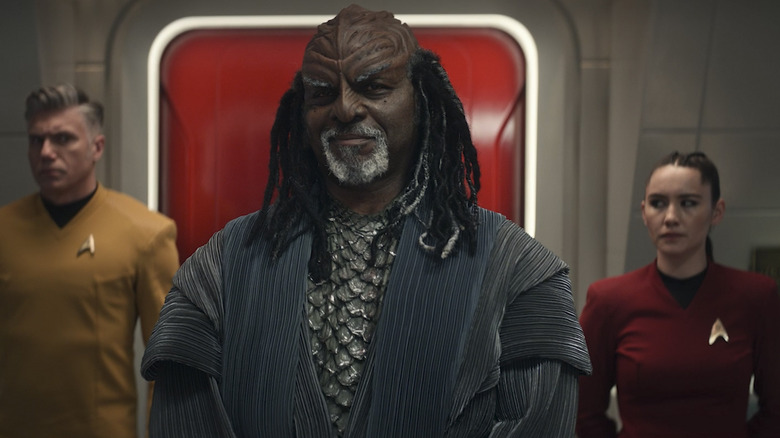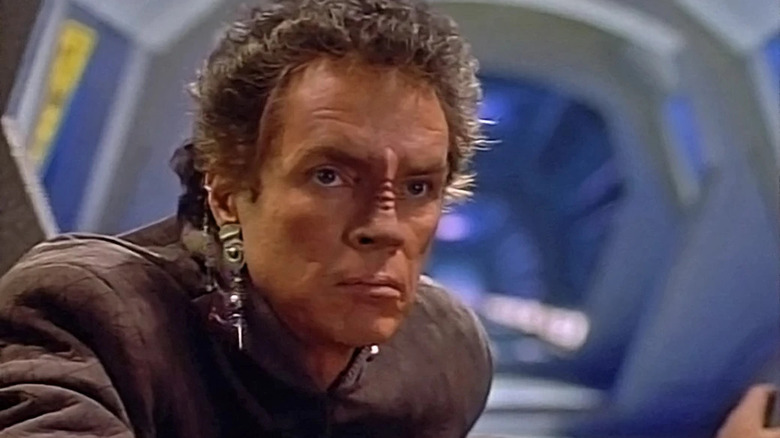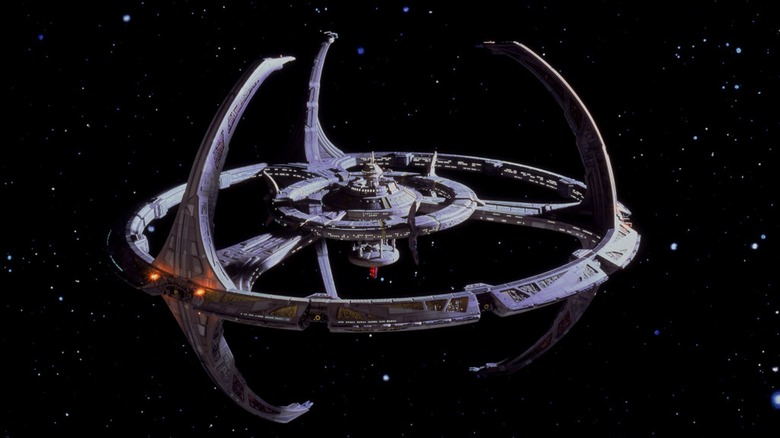Star Trek: Strange New Worlds's Latest Storyline Darkly Mirrors One Of Deep Space 9's Best Episodes
War has always been a touchy subject for "Star Trek." Throughout the original series, the Federation had formed an uneasy alliance with the Klingons and was not on the rosiest terms with the Romulans, so war was constantly hanging over everyone's heads. There were occasional episodes involving combat or espionage, but there were no outright full-scale battles; that's not what "Star Trek" was about. A large part of Gene Roddenberry's utopian future was a devotion to pacifism. Being strong was now defined by one's ability to reason, to help others. It was no longer about might or domination.
But, it seems, "Star Trek" had a long way to go. In the episode "Patterns of Force" (February 16, 1968), William Shatner and Leonard Nimoy, both Jewish actors, were required to put on Nazi uniforms and read lines about how, welp, the Third Reich may have been evil, but they got the trains running on time. The characters — and one might sense some of the show's writers — were still drawn to tantalizing ideas about battlefield might and wartime power.
It wouldn't be until later in the franchise that "Star Trek" became more resolute in its views of war. On "Star Trek: The Next Generation," everything was stringently diplomatic and war was never suggested as a possibility to solve anything. Indeed, it was to be avoided at all costs.
On "Star Trek: Deep Space Nine," however, war became far more complicated. It seems that military occupation, genocide, trauma, murder — everything that comes with war — were still alive and well ... and still needed to be confronted.
The latest episode of "Strange New Worlds," called "Under the Cloak of War," borrows DS9's complexity, echoing the episodes "The Homecoming," "The Circle" and "The Siege." Both are about former war criminals.
Dak'Rah vs. Li Nalas
Dak'Rah, it is slowly explained in "Under the Cloak of War," led a notorious offensive against a Federation outpost during the war. He infamously gave the order to spare no lives and advocated the killing of civilians, including children. Years later, Dak'Rah defected from the Klingon Empire and was now a diplomat for the Federation. He was, he said, attempting to put the horrors of war behind him, forget his crimes as best he could, and devote his life to peace. When Dak'Rah visits the U.S.S. Enterprise, however, Dr. M'Benga (Babs Olusanmokun), Nurse Chapel (Jess Bush), and Lieutenant Ortegas (Melissa Navia) can't see past his crimes and feel nothing but hate and rage.
Later, however, a quandary arises. Was Dak'Rah really the battlefield butcher he was credited as ... or was it someone else? Yes, Dak'Rah committed acts of violence, but what if the identity of the notorious battlefield butcher was closer to home?
Comparisons may be drawn to Li Nalas (Richard Beymer), a Bajoran freedom fighter from the opening three-part episode of the second season of "Deep Space Nine." With Li, however, the morals are a little more complicated. Some background: "Deep Space Nine" takes place after a militant and fascist species called the Cardassians had just ended a decades-long occupation of the planet Bajor. The Bajorans were slaughtered and enslaved, but eventually formed a resistance, and fought back. "Deep Space Nine" took place during a fragile Bajoran reconstruction when the planet, still damaged from the occupation, was teetering into the hands of its own corrupt theocracy.
During the early days of the reconstruction, the Federation sought Bajoran leaders or strong political figures to fill the power vacuum, and for a moment, it seemed like Li Nalas might be the one.
Li Nalas, con't.
For a moment, it looked like Bajor might actually be ready to break out into a civil war. Li Nalas was praised as a war hero who bravely hunted down Cardassian battlefield butchers and killed them by the score. Captain Sisko (Avery Brooks) felt that the Bajorans required someone like Li to lead the people and unite them. Li, however, confesses the truth to Sisko; he didn't take part in most of the battlefield victories attributed to him. He only emerged as a war hero because he shot and killed one Cardassian, kind of by accident, while the Cardassian was bathing naked in a river. He's not the bold murderer that the people seem to think he is. At the end of the day, he had to pretend to be a war hero in order to fulfill a political function. In truth, he just wanted peace.
One can see the parallel between Li Nalas and Dak'Rah. Both fought bravely for their side, but neither was the monster they were said to be nor did they want to be war heroes. Ultimately Li Nalas is told by others that he needed to be a saint. Dak'Rah, in contrast, pointed out that he constructed a post-war persona for himself as an aggrieved but bravely reformed Klingon warrior. "People need saints," he says. "If people knew the truth, my work would be undone."
Both Li Nalas and Dak'Rah used their post-war position to make vital political advancements. Not for themselves or their egos, but for the benefit of the galaxy at large. Both ultimately were determined to stop war altogether, and reluctantly played along to move pieces around on a diplomatic chess board.
They also both met violent ends, however. War, it seems, continues to kill in perpetuity.


